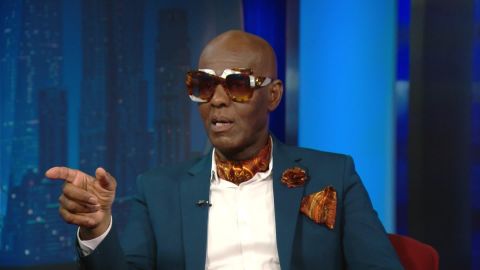Read Transcript EXPAND
CHRISTIANE AMANPOUR: Fashion week is underway in New York City right now, and we get a master class in style from the iconic designer, Dapper Dan, born and raised in Harlem, his legendary designs are inspired by the neighborhood he loves. Now, partnered with Gucci, Dapper Dan told our Hari Sreenivasan how he worked his way up from nothing and what gives someone style.
(BEGIN VIDEOTAPE)
HARI SREENIVASAN, CORRESPONDENT: All right, Daniel Day, you’ve got yourself a partnership with Gucci, a book deal with Random House, a picture deal with Sony, not bad for a kid who grew up good at dice —
DANIEL DAY, DAPPER DAN, HIGH FASHION DESIGNER: Yes.
SREENIVASAN: — dealing, hustling on the streets.
DAY: Yes.
SREENIVASAN: How did you find the angle to be someone that stuck out?
DAY: Fortunately for me is that I’m the first generation of the great migration that came from the south. My father, born in 1898, so he arrivedin New York in 1910, right, he’s 12-years-old. I didn’t even understand that, you know what I’m saying? But only the strongest stayed. So, we’ve got the strongest black men coming out of reconstruction from the south.
SREENIVASAN: Yes.
DAY: So, my father was one of them. So, I’m growing up that kind of an atmosphere. And I’ve got three older brothers and then two cousins up-state. So, I got access to all this knowledge, you know, all this energy – –
SREENIVASAN: Yes.
DAY: — and so, that’s what gave me the strength to be able to make it.
SREENIVASAN: And you were one of the last generations to witness Harlem pre-drug epidemic?
DAY: Yes. I remember a Harlem like 11:00 o’clock Sunday morning you see everybody emptying out of their houses. Everybody going into church. You left your doors open. It was — I saw — I saw Harlem when it was a village. So, you found sections of Harlem everybody here was from South Carolina, everybody over here was from Virginia.
SREENIVASAN: So they’re block-by-block?
DAY: Yes, block-by-block. What this amount to, that kind of village feeling, is when they start building public housing and projects and that took away from that. But, that’s not the Harlem I grew up in.
SREENIVASAN: How did you get to be so good at dice by the time you were —
DAY: That’s the first — gambling was the first thing I learned. And let me tell you why. We had what’s called the rent parties. A rent party is like you were in a circle of people, like neighbors — my father, neighbors and all that, and once everybody get a week that they have a party and you served chicken, potato salad, collared greens and they had gambling there, right? So, as a little — as a young boy I watched my father gamble and that’s the first experience I had. And then my Uncle Eddie, they called him Fishman Eddie, he had ran away when he was young and joined the circus and there was a guy in the circus that taught him all these tricks with cards and dice, and so, that was the first experience — that was the first thing I learned about street hustling.
SREENIVASAN: Yes.
DAY: But I took it even further than that, because when I learned everything there was that I could learn from the older guys, concerning gambling, then I read all the books by John Carney. John Carney is the world authority for the United States government on gambling, he advised the government on casinos and everything.
SREENIVASAN: Yes.
DAY: He was the master. So, us — I got the street knowledge and then I went and got all the book knowledge, so that I could learn everything it took. So, I was undefeatable.
SREENIVASAN: Is there a moment you remember when the gambling turned into drugs?
DAY: I only knew of jazz musicians during the ’50s that used drugs, but it wasn’t a general thing, you know. And then as the ’60s, during the Vietnam War, then it, you know, it escalated. It just spread out, and that’s when we went through our first epidemic, and I got caught up in that.
SREENIVASAN: Yes.
DAY: The amazing thing was like me and all four of my brother, we all got caught up into selling drugs. We all got arrested together, but while I was arrested I began to read a lot and study a lot, and I wanted to know what happened. So as soon as I got out, I went to the library – county color library. It was just part of the Shomburg Library. I wanted to find out why this drug thing happened, so I studied the Opium War and what China did, the Boxer Rebellion, and then I became very political, and that was the end of that for me. I said I would never engage in something that would have that kind of negative effect on my community.
SREENIVASAN: So were you born with a sense of style? Did you absorb it in the Harlem that you grew up in? How did it happen?
DAY: Let me tell you, listening to the older guys, watching them, like we have today what we call influences like – you know, hip hop music created all these influences, but that’s not a new thing. When I was growing up, I used to listen to my brothers now, and they would follow these Hollywood actors, and it had to be a particular – it had to be the type of tough guy acting who stands up against the system and is the way they dress. So my brothers and them used to pattern themselves back coming up in the 50s was Humphrey Bogart, George Raft, you know, only ones who played them tough guy, gangster roles. So everyone wanted to dress – Edward G. Robinson, you know? And then later on the style shifted to the Rat Pack, Sammy David Jr. –
SREENIVASAN: Yes.
DAY: — you know, and that now. And then after that, I started developing a different style all alone by myself.
SREENIVASAN: What defines style to you? When you see someone walking down the street, what makes you say, “That person has style,”?
DAY: Style is not a person. Style is a manifestation, the culture that comes alive in an individual who represents that culture. You know, when you look at the jazz musician, you know, the way – style might – they might just take a hat and toss it a certain way or use colors a different way, you know? So that’s what it is. It’s like first it’s the culture, and then out of the culture comes the style. I always tell young designers interpret the culture because that’s going to make a difference, you know?
SREENIVASAN: So how did you get the money to start the store?
DAY: You want to learn? I’m going to give you a new term. In Harlem, there’s what we call flat foot hustlers. A flat foot hustler is a person who can wake up in the morning broke and come home with money.
(LAUGHTER)
So let me show you how that works, right? In Harlem – all over Harlem at the time we had what’s known as street crap gangs, and it’s just – it works just like Las Vegas. Somebody controls the momentum that takes place in the game, so you put your money up, people just money up. So I get up in the morning. I get up at 6 o’clock in the morning. I go and I take some dice and I put it out on the street. That makes me – I’m the casino. I’m the one conducting that. Everybody pays me to participate in that game.
SREENIVASAN: You’re the house.
DAY: I’m the house.
SREENIVASAN: And the house always wins.
DAY: And the house always wins. And so, I generated money like that because I refused – completely refused to go back – to be involved in any drug culture. In addition to that, I wanted to engage in things that wouldn’t hurt my community. So there’s – in Harlem, there’s another game they call the paper game. The paper game is checks and credit cards and that. And so, I delved into that for a little while, you know, because I felt like big banks – I felt like John Dillinger, you know? Everybody rooted for him because he wasn’t robbing people. He was robbing banks, you know? You know, and there’s something special when you can take a pen and rob a bank. You know, and so, that’s what the paper game was-
(CROSSTALK)
SREENIVASAN: So it’s just fraudulent checks, fraudulent credit cards.
DAY: Yes.
SREENIVASAN: Nice games.
DAY: Yes, yes.
SREENIVASAN: That is your seed capital to start –
DAY: Exactly.
SREENIVASAN: — the store.
DAY: Yes.
SREENIVASAN: So you set up shop, and how does it occur to you to take global, European brands and putting your own spin on them? You call them knock ups, not knock offs. What does that mean?
DAY: A knock up is when you take a brand interpreted to your culture, and to them and to the world eventually it looks better than where it started from, you know? And so, that’s what I did. How did I do it? I did it by this way. One day a guy came into the store. Big gangster, top notch gangster in Harlem, you know? And he’s affiliated with John Gotti brother, Gene Gotti. He came in the store and he had a pouch – a Louis Vuitton pouch full of $100 bills, you know. Everybody’s excited about that pouch because it’s Louis Vuitton, right? And I say, “It’s only $5.” I say that’s – you know, I’m making – I’m dealing with fabric. I know what that’s worth, you know, production-wise. It’s like $5 worth of vinyl, but I say, “What is it?” I say it’s the symbols. It’s the symbols on that pouch. So I said those symbols had as much power as the fur coats that I was making and the plage leather jackets that I’m making. So I said if I can take them symbols and put them on leather and have more clients looking like luggage, that would have the same effect as if I made them a fur coat. And so, that made me the idea to going into doing what I’m known for today, logomania.
SREENIVASAN: So how did you get LL Cool J and Eric B. & Rakim and Salt-N- Pepa to start wearing your stuff?
DAY: Well, it was a new genre. They couldn’t pay me. Some of them still owe me money to today. Well, so here’s the birth of a new fashion ideas that’s coming along, right? Logomania. So when the rappers started to come, they’re looking for a new look, right, and this is a new look. So now these designer bags and stuff like that is popular. There’s a new musical genre that’s popular. So Eric B. & Rakim and LL Cool J, the rappers is making a lot of money and they want their own look, so I started giving them their own look, and that’s why they started coming. I started giving them the logomania look, you know, the Gucci, the M.C. of the Fendi, the Louis Vuitton.
SREENIVASAN: So how do you get a look for a person? When you sit down and you start talking to them before you design with them, what are you looking for? What makes a –
(CROSSTALK)
DAY: That’s an important question.
SREENIVASAN: — what makes a jacket an LL Cool J jacket?
DAY: That’s an important question because, you know what? In fashion it’s hard to stay relevant. And my way to address that is every – I’m a – every person that came into my store, we design together. I ask them, “How do you want to look? How do you feel? What kind of message you want to send?” So I’m not designing completely from my mind. I’m translating a cultural aspect of how they represent themselves, so that’s what I did with fashion. When they came in – one of the significant things – and that’s important that you mentioned Eric B. & Rakim because when you look at the – one of the more famous jackets that I made, the gold and black, when Eric B. has his on, he has the Gucci sign on the back. When Rakim has his on, he has his religious symbol on the back. So everything I created I used these symbols, but I design them in a way where the customer feels this is the look they want to have.
SREENIVASAN: So you’re almost describing to me in a way that fashion is also about power.
DAY: Yes. Yes. Fashion’s about power, and that’s why I always tapped into that. That’s why to start out with I said what my clientele’s going to be. Middle class, people of color are not going to buy from me. This is like, no, we’re going to Gucci. We’re going to Louis. But the gangsters – my first clientele – they didn’t care about was it – it came from these designer houses or not. If it was cool, they was going to wear it. So what I did was I tapped into the power, you know? The gangsters, everybody want – they were the stars in the hood, so everybody wanted to look like them and the rappers wanted to look like them. The strength when I was designing was the popularity of those who had the most money, and that was the gangsters. So I designed with them in mind and I start with them.
SREENIVASAN: So did it give you pause? Here you are making money in the shop and you’re dealing with gangsters. They’re making their money – really they’re profiting from someone else’s pain, and that’s how you’re benefiting.
DAY: Yes.
SREENIVASAN: That’s how you’re keeping your family fed.
DAY: Exactly. Yes, but you can’t be in it and not of it, you know? And so, it’s – what I realized is I’m a product of those who I’m dealing with, you know? So I’m wrestling with that, and I’m really – I’m really not happy, but it’s with being in the street on that level, but I like what I’m doing. So eventually what happens is – which is always what – I see it happen with the drug game – it implodes. The drug community starts fighting among themselves, killing among themselves. They look around. There were so many people selling drugs, so nobody was really making any money. So as a result of that, they started looking at other people. I’m open 24 hours a day.
SREENIVASAN: Your shop was open 24 hours?
DAY: My shop was open 24 hours a day, 365 days for ten years straight. And so, there’s a lot of kidnapping going on and robbery going on and they attempted to kidnap me. And I resisted and I got shot. Have a bullet in my neck. And then after that, I recovered from that. Then the brands result to me using trademarks. Then the brands took notice.
SREENIVASAN: So one of the lawyers who came in to basically help close your shop–
DAY: Yes.
SREENIVASAN: — she’s working for Fendi.
DAY: Yes.
SREENIVASAN: Her name is–
DAY: Yes, (inaudible). Yes, she’s a justice under Supreme Court today. A wonderful lady, I have to say that there. I remember the day she (inaudible) me. She came in the store and I just finished a coat for a popular rapper, Big Daddy Kane. And it was a (inaudible), like a full length (inaudible) with a tuxedo black glamour color, black (inaudible) leather with black on black Fendi logos all over it. And she seen that coat, she said this is amazing. This guy really belongs downtown. But of course she raided me and they took all the Fendi stuff out. Yes, (inaudible). And as a result of that, the raise kept coming like that there, so I closed down and went underground.
SREENIVASAN: So what happens when you go underground?
DAY: When I went underground, I had already built up a clientele for all the gangsters and hustlers in all the cities in the Unites States. So what I did was I would make up clothes and go from in New York to Chicago hitting all the black cities and then come back to New York. And then go from New York to Atlanta hitting all the black cities, and that’s how I sustained myself for 20 years underground.
SREENIVASAN: So 20 years fast-forward, Gucci rolls out a piece. Social media goes bananas because it looks so similar to what you designed for am Olympic athlete 25 years prior to that. And that really helps you restart.
DAY: Yes. It’s amazing because Gucci says look, we had every intention to let the public know that this is Dapper Dan’s creation. We just took it for granted, everybody know, there was — they meant — and I take them for that to pay homage to me. And it was paying homage, right? And they just didn’t say that in the beginning, but they’ve just took it for granted that everybody knew. But black Twitter went in on them.
SREENIVASAN: Right.
DAY: But they said that’s OK. So what Gucci did, they came to me, got in touch with my son. I said are they serious? He said yes. I said no, they ain’t serious. He said no, dad, they want to talk to you. They want to do a deal. I said no, (inaudible). I don’t believe it. I said tell them come to Harlem if they want a deal. And they came to Harlem, right? I said I don’t want no collaboration. What do you have for me? They said we’ll give you a partnership. And we’ll open up a (inaudible) in Harlem where you can do everything that you’ve always done but you just use our fabrication.
SREENIVASAN: And now you’re legit.
DAY: Yes. And you know what really got me excited, they said we know and the world knows who you are now, all right? And everybody’s paying you homage but nobody paid you. So we’re here to change that. And that’s what this deal was about.
SREENIVASAN: So you’re working with Gucci, then there’s this balaclava incident–
DAY: Yes.
SREENIVASAN: — where they roll out a turtleneck that basically looks like it’s black face.
DAY: Yes.
SREENIVASAN: What goes through your mind as soon as you see that?
DAY: Well, as soon as I seen that, I’m a student of history, especially black history, right? I know that this wasn’t intentional. But intentional or not, if you shoot somebody by accident or you shoot them on purpose and they die, they still dead. So, I told Gucci, I said — I had to announce to the public because now my community’s up in arms, I’m up in arms. So I said look, I’m a black man before I’m a brand. Gucci, I want you to come here and explain to the community what happened. I trust that this was an accident. Marco Bizzarri, CEO of Gucci came to Harlem and we sat down. We said this is what we’re going to do. We’re going to put money in this community. We’re going to develop designers. Now we have like a vice — two vice presidents of color working for Gucci. They came with this whole program and I took that program and I ran with it and I let the community know this is what Gucci is doing. Sand I think this is phenomenal. This is like we have a global footprint now.
SREENIVASAN: Ironically, 25 years ago you were actually exposing these European brands to consumers that they were never going to reach anyway. They had no interest in reaching, because they also–
DAY: Yes.
SREENIVASAN: — didn’t think that that consumer had money. And all the sudden they’re saying wait, how do we — how do I reach that?
DAY: Yes. The hip hop artists couldn’t even pay me back then. Now you have Jay-Z. He’s getting — he’s a billionaire now. Hip hop is really big now. They’re the enforcers for the brand. And so, it’s a complete turnaround.
SREENIVASAN: Dapper Dan, thanks so much for joining us.
DAY: Yes.
About This Episode EXPAND
Sediq Sediqqi joins Christiane Amanpour to weigh in on President Trump’s cancelled secret peace talks with Taliban leaders, followed by Saad Mohseni, who explains what went wrong and what lies ahead for Afghanistan. Plus, Camilla Cavendish discusses the latest Brexit developments and fashion designer Dapper Dan speaks to Hari Sreenivasan about style and his life journey.
LEARN MORE



